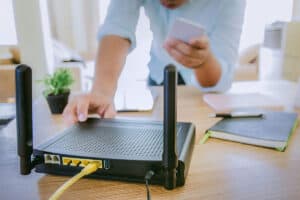No Internet Access? Diagnose and Fix Your Wi-Fi Connection

You connect your device to Wi-Fi expecting seamless internet access, but the browser fails to load pages, streaming apps stall, and emails won’t sync. This frustrating scenario—Wi-Fi connected but no internet—has become increasingly common. The surge in remote work, higher online activity, and occasional network disruptions contribute to these internet connection issues that interrupt productivity and business life.
Understanding why your device reports a Wi-Fi connection while lacking actual internet access is integral. Quick diagnosis and effective troubleshooting save you time and reduce stress from unexpected downtime. Ignoring the problem often leads to extended outages or worsened connectivity.
Below, we provide a clear, practical approach to get your internet back on track. Through step-by-step instructions tailored for various devices and setups, you’ll learn how to identify underlying causes—from ISP outages and hardware glitches to software conflicts—and fix them efficiently. Use this guide as a reliable resource whenever you face no internet connection troubleshooting challenges.
Understanding the Problem
When you connect to a Wi-Fi network but can’t access the internet, it can be frustrating. This situation occurs when your devices can join the wireless network, but they can’t reach any online content. In other words, you’re connected to Wi-Fi, but there’s no internet connection.
Common Reasons for Internet Connection Issues
Several factors can contribute to this problem:
- ISP Outages: Sometimes, your Internet Service Provider (ISP) may experience outages or issues that affect your internet connection.
- Hardware Faults: Problems with your router or modem can also lead to internet connectivity issues. These devices are responsible for establishing and maintaining your internet connection.
- Incorrect Settings: Misconfigured settings on your router or device can prevent proper communication with the internet.
- Device-Specific Errors: Occasionally, specific devices may encounter errors that prevent them from accessing the internet, even if other devices on the same network are working fine.
Step-by-Step Troubleshooting Guide
Initial Checks
When faced with a Wi-Fi connectivity issue, it’s vital to start with some initial checks to pinpoint the root cause. Here are steps to take:
- Use Cellular Data or Websites for Outage Status: If you suspect an internet outage, leverage your cellular data or visit websites like Down Detector and Thousand Eyes Outages Map to check your ISP’s status. This quick check can help you determine if the problem lies with your provider.
- Inspect Physical Connections: Ensure all physical connections to your modem/router are secure. Check Ethernet cables and power supplies for any loose connections or damage that could be impeding your internet access.
- Test Connectivity via Ethernet Cable: To differentiate between Wi-Fi issues and overall connectivity problems, try connecting directly to your modem/router using an Ethernet cable. This direct connection can help isolate where the issue might originate.
Step 1: Reboot Modem and Router
Rebooting your modem and router can often fix temporary issues that are causing you to lose internet access. Here’s how to do it safely:
- Turn Off Devices: Power down your modem and router by unplugging them from the power source.
- Wait for Time Delay: Leave them unplugged for at least 30 seconds to ensure a complete shutdown.
- Power On Modem: Plug in your modem first and wait for it to fully restart. This process may take a few minutes.
- Power On Router: Once the modem is online, plug in your router and give it time to boot up.
- Check Connectivity: After both devices are back online, test your internet connection on a device to confirm restoration.
This simple step often resolves common connectivity issues caused by minor disruptions in the network. If you’re still having problems after rebooting, move on to the next troubleshooting steps for further resolution.
Step 2: Verify Router Settings and Permissions
Accessing your router’s admin interface can help diagnose Wi-Fi connectivity issues. Most routers use a default gateway IP address such as 192.168.1.1 or 192.168.0.1. To open this:
- Connect to your Wi-Fi network.
- Open a web browser.
- Enter the default gateway IP into the address bar.
- Log in using the router’s admin username and password (often found on the device label or in its manual).
Once inside, review key settings that might block internet access for some devices.
- MAC Address Filtering: This security feature restricts which devices can connect based on their hardware addresses. If enabled, ensure your device’s MAC address is listed as allowed. Remove any unknown or blocked entries.
- Parental Controls or Access Restrictions: These can inadvertently prevent internet usage by certain devices or during specific times.
- Firmware Updates: An outdated router firmware can cause intermittent connectivity problems; check for updates in the settings menu.
Checking these permissions helps confirm your network isn’t unintentionally blocking devices from accessing the internet.
Step 3: Troubleshoot Device Network Settings and Software Conflicts
If you’re still having trouble connecting to the internet, there might be an issue with your device’s network settings or software. Here are some steps you can take to troubleshoot these potential problems:
Check Wi-Fi Network Password
If you’ve recently changed your Wi-Fi password, it’s possible that your device is still trying to connect using the old password. To fix this, you can forget the Wi-Fi network on your device and then reconnect using the new password.
- On Windows: Go to Settings > Network & Internet > Wi-Fi > Manage known networks. Select the Wi-Fi network and click on “Forget.” Then, reconnect to the network by selecting it from the available networks list and entering the new password.
- On Mac: Click on the Apple menu > System Preferences > Network. Select Wi-Fi from the left sidebar and click on “Advanced.” Find the Wi-Fi network in the list, select it, and click on the “-” button to remove it. Then, reconnect to the network by clicking on the Wi-Fi icon in the menu bar and selecting the network from the list.
Disable VPN or Proxy
Sometimes, VPNs (Virtual Private Networks) or proxy servers can interfere with your internet connection. If you’re using a VPN or proxy, try temporarily disabling it to see if that resolves the issue.
- To disable a VPN on Windows: Right-click on the VPN connection in the system tray and select “Disconnect.”
- To disable a VPN on Mac: Click on the Apple menu > System Preferences > Network. Select VPN from the left sidebar and click on “Disconnect.”
- To disable a proxy on Windows: Go to Settings > Network & Internet > Proxy. Turn off any enabled proxy settings.
- To disable a proxy on Mac: Click on the Apple menu > System Preferences > Network. Select your active network connection (Wi-Fi or Ethernet) from the left sidebar and click on “Advanced.” Go to the Proxies tab and uncheck any enabled proxy settings.
Step 4: Perform Network Reset on Windows Devices
If you’re still having trouble with your internet connection, you can try performing a network reset on your Windows device. This action will remove all network adapters and set everything back to its original settings. Here’s how to do it:
Use Built-in Windows Troubleshooting Tools
Before proceeding with a network reset, it’s worth trying the built-in Windows troubleshooting tools. These tools can automatically diagnose and fix common network issues. To access them:
- Go to Settings by pressing Windows + I.
- Select Update & Security.
- Click on Troubleshoot in the left sidebar.
- Choose Internet Connections and run the troubleshooter.
This may resolve any temporary glitches affecting your internet connection.
Steps for Performing a Full Network Reset
If the troubleshooting tools didn’t work, you can perform a full network reset using these steps:
- Open Settings again (Windows + I).
- Click on Network & Internet.
- Scroll down and select Network Reset at the bottom.
- Click on Reset Now and confirm your action.
Your computer will restart, and all network settings will be restored to default.
Step 5: Scan for Malware and Temporarily Disable Security Software
Malware can sometimes interfere with your internet connection. To rule out this possibility, it’s essential to run a comprehensive scan using your security software. If you’re using Windows, you can utilize Windows Defender, which comes pre-installed on most devices. Alternatively, you may prefer to use Malware Bytes, a popular third-party antivirus program known for its effectiveness in detecting and removing malware.
Run a Malware Scan
Follow these steps to run a malware scan:
- Open your security software (Windows Defender or Malware Bytes).
- Look for the option to perform a full system scan.
- Start the scan and wait for it to complete.
- Review the scan results and take appropriate action if any threats are detected.
Temporarily Disable Firewall/Antivirus Software
In some cases, your firewall or antivirus software may mistakenly block legitimate internet traffic, causing connectivity issues. To determine if this is the case, you can temporarily disable these security features and check if your internet connection improves.
Here’s how you can temporarily disable these security features:
- Open your firewall or antivirus software.
- Look for the option to disable or turn off the protection temporarily.
- Confirm any prompts that may appear.
- Test your internet connection to see if it resolves the issue.
When To Contact Your Internet Service Provider (ISP) or Seek Professional Help
Sometimes, the internet problems you’re facing may be beyond your control and require assistance from your Internet Service Provider (ISP) or a professional technician. Here are some situations when you should consider reaching out for help:
1. Persistent Issues
If you’ve tried all the troubleshooting steps mentioned earlier and you’re still experiencing internet problems, it’s time to contact your ISP. They may be able to identify any outages or issues on their end that could affect your connection.
2. Possible Hardware Failures
In some cases, the issue may lie with your modem, router, or other networking equipment. If you suspect that there might be a hardware failure, it’s best to seek professional help. A technician can diagnose the problem and recommend any necessary repairs or replacements.
3. ISP Outages
ISPs occasionally experience outages due to maintenance work or technical difficulties. If multiple devices are unable to connect to the internet, it’s worth checking with your ISP to see if there are any reported outages in your area.
4. Complex Network Issues
If you have a more complex network setup involving multiple devices, smart systems, or specific configurations, it may be beneficial to consult a professional. They can assess your network setup and provide tailored solutions for any issues you’re facing.
Remember, ISPs often have remote troubleshooting capabilities and can send technicians if needed. Don’t hesitate to reach out for assistance when you’re unable to resolve internet problems on your own.
Empowering Your Connection: Keeping Your Internet Stays On
Dealing with this frustrating issue requires patience and a systematic approach. When troubleshooting steps become overwhelming or ineffective, don’t hesitate to seek expert help. Early intervention by an IT professional or your ISP can save time and prevent further complications.
Maintaining a robust network setup is essential for uninterrupted connectivity—especially as more people work remotely and rely on stable internet access daily. Regularly updating your router’s firmware, placing it optimally, and monitoring device connections help keep your network running smoothly.
Take these key points away:
- Don’t ignore persistent issues; early professional support often resolves problems faster.
- Keep your network equipment and settings up-to-date to avoid common pitfalls.
- Test your connection frequently to catch issues before they escalate.
FAQs
Why am I connected to Wi-Fi but I have no internet access?
Being connected to a Wi-Fi network without internet access can occur due to ISP outages, hardware faults like modem or router issues, incorrect network settings, or device-specific errors. Although your device joins the wireless network, it cannot reach online content until these problems are resolved.
How can I check if my internet service provider is experiencing an outage?
You can use websites such as Down Detector and Thousand Eyes Outages Map on a cellular data connection or another network to verify if your ISP is facing an outage. These platforms provide real-time information about widespread connectivity issues affecting your area.
What are the first steps to troubleshoot when Wi-Fi shows connected but no internet connection?
Start by inspecting all physical connections like Ethernet cables and power supplies for your modem and router. Then, try connecting your device directly via an Ethernet cable to determine if the issue lies with Wi-Fi or overall internet connectivity. Also, rebooting your modem and router can often resolve temporary glitches causing loss of internet access.
How do I verify and adjust my router settings to fix no internet connectivity?
Access your router’s admin interface using its default gateway IP address through a web browser. Check for settings such as MAC address filtering or parental controls that might block certain devices from accessing the internet. Adjust these permissions accordingly to restore connectivity.
What should I do if my device’s network settings or software are causing no internet despite Wi-Fi connection?
Forget and reconnect to the Wi-Fi network, especially after password changes, to resolve authentication issues. Temporarily disable VPNs or proxy servers that may interfere with connectivity. On Windows devices, performing a full network reset via Settings can also help repair misconfigurations.
When should I contact my ISP or seek professional help for WiFi connected but no internet problems?
If persistent connectivity issues remain after performing standard troubleshooting steps like checking hardware, resetting devices, and verifying settings, it’s advisable to contact your ISP. They can remotely diagnose issues or dispatch technicians for hardware repairs. Early expert intervention helps restore reliable internet access efficiently.
About the Author
Author’s recent posts
Download the
Business Owner’s Cybersecurity Blueprint


